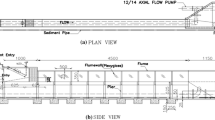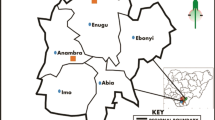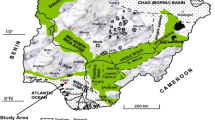Abstract
Headcut, known as knickpoint migration too, is developed due to sudden change in channel bed followed by bed scour and erosion which progressing upstream. The results are the downstream morphological change and transporting massive sediment to the downstream reservoir. Most of the past studies focus on non-cohesive soils, although many problems occur because of cohesive soils. In this study, 10 different samples of cohesive soils in long term consolidation with different composition of silt and clay were tested under different circumstances of waterfall height and flow velocity to investigate the neck migration rate and the sediment yield. Tests were continued to reach a constant migration rate. One of the effective phenomena in all tests was tensional cracks on soil surface. The size and number of these cracks have inverse relation with percent of clay. Because of these cracks, massive erosion occurs at the beginning of all tests. By reducing percent of clay, headcut, waterfall height and sediment yield were increased and by reducing waterfall height and flow velocity these parameters were reduced. In lower percent of clay, headcut erosion will occur quickly with more slants. Caving phenomenon was not observed in any tests and massive erosion rate was more quickly.
Similar content being viewed by others
References
Brush, L.M., Wolman, Jr., and Wolman, M.G., Knickpoint behavior in noncohesive material: a laboratory study, J. Geol. Soc. Am. Bull., 1960, vol. 71, no. 1, pp. 59–74.
Bryan, R.B., Knickpoint evolution in rillwash, in Soil Erosion-Experiments and Models, Bryan, R.B., Ed., Catena Supp., 1990, vol. 17, pp. 111–132.
Elliot, W.J. and Laflen, J.M., A process-based rill erosion model, Trans. ASAE, 1993, vol. 36, pp. 65–72.
Gardner, T.W., Experimental study of knickpoint and longitudinal profile evolution in cohesive, homogenous material, J. Geol. Soc. Am. Bull., 1983, vol. 94, pp. 664–672.
Goy, P.N. and Jung, Y., Headcutprevention, 2013. www. engr.colostate.edu/~pierre/ce_old/classes/ce717/PPT%202013/HW4_Headcut.pdf.
Holland, W.N. and Pickup, G., Flume study of knickpoint development in stratified sediment, J. Geol. Soc. Am. Bull., 1976, vol. 87, pp. 76–82.
May, J.H., Geotechnical Aspects of Rock Erosion in Emergency Spillway Channels. Report 4, Geologic and Hydrodynamic Controls on the Mechanics of Knickpoint Migration. Technical Report REMR-GT; 3. Vicksburg, MS: U.S. Army Engineer Waterways Experiment Station, 1989.
Merritt, E., The identification of four stages during micro-rill development, Earth Surf. Processes Landforms, 1984, vol. 9, no. 5, pp. 493–496.
Meyer, L.D., Foster, G.R., and Nikolov, S., Effect of flow rate and canopy on rill erosion, Trans. ASAE, 1975, vol. 18, pp. 905–911.
Moore, J.S., Temple, D.M., and Kirsten, H.A.D., Headcut advance threshold in earth spillways, Bull. Assoc. Eng. Geol., 1994, vol. 31, pp. 277–280.
Morgan, R.P.C., Soil erosion and conservation, 2nd Ed., Longman, 1995.
Mosley, M.P., Experimental study of rill erosion, Trans. ASAE, 1974, vol. 17, pp. 909–913.
Parker, P.S., The effect of urbanization on headcut migration, University of Vermont, Burlington, 05401, The 1st Annual Res. Sympos., 2009.
Poesen, J., Nachtergaele, J., Vertsraeten, G., and Valentin, C., Gully erosion and environmental change: importance and research needs, Catena, 2003, vol. 50, pp. 91–133.
Powledge, G.R., Ralston, D.C., Miller, P., Chen, Y.H., Clopper, P.E., and Temple, D.M., Mechanics of overflow erosion on embankments, Research activities, J. Hydraul. Eng., 1989, vol. 115, pp. 1040–1055.
Quebbeman, J., Steininger, A., and Williams, R., Headcut prevention, CIVE 717: Assignment no. 4, 2012.
Robinson, K.M. and Hanson, G.J., Large-scale headcut erosion testing, Trans. ASAE, 1995, vol. 38, pp. 429–434.
Robinson, K.M. and Hanson, G.J., Gully headcut advance, Trans. ASAE, 1996, vol. 39, pp. 33–38.
Robinson, K.M. and Hanson, G.J., Influence of backwater on headcut advance, in Proc., North Am. Water Enviro. Congress, Am. Soc. Civ. Engrs., Anaheim, CA, 1996, pp. 117–122.
Römkens, M.J.M., Prasad, S.N. and Helming, K., Sediment concentration in relation to surface and subsurface hydrologic soil conditions, Proc. 6th Federal Interagency Sedimentation Conf., Las Vegas, Nev., 1996, vol. 2, pp. 1X9–1X16.
Römkens, M.J.M., Prasad, S.N. and Gerits, J.J.P., Soil erosion modes of sealing soils: a phenomenological study, J. Soil Technol., 1997, vol. 11, no. 1, pp. 31–41.
Sundquist, B., Topsoil Loss-causs, Effects and Implications, Sci., 2000, vol. 63, pp. 70–71.
Temple, D.M., Estimating flood damage to vegetated deep soil spillways, J. Appl. Eng. Agric., 1992, vol. 8, pp. 237–242.
Temple, D.M., Brevad, J.A., Moore, J.S., Hanson, G.J., Grissinger, E.H., and Bradford, J.M., Analysis of vegetated earth spillways, 10th Annual Conference, Assoc. of State Dam Safety Officials, Kansas City: Mo, 1993, pp. 225–230.
Temple, D.M. and Hanson, G.J., Headcut development in vegetated earth spillways, J. Appl. Eng. Agric., 1994, vol. 10, pp. 677–682.
Vinogradova, N.N., Environmental effects of the bottom sediments of the Senezh Reservoir, Water Resour., 2001, vol. 28, no. 1, pp. 78–83.
Wilcox, J., Benoit, T., and Mink, L., Evaluation of geomorphic restoration techniques applied to fluvial systems, Feather River Coordinated Resource Management Group, 2001, Section 4, pp. 43–47.
Zhu, Y., Visser, J.P., and Vrijling, K.J., Soil headcut erosion: process and mathematical modeling, J. Sedim. Ecohydraul., 2005, vol. 9, pp. 125–136.
Author information
Authors and Affiliations
Corresponding author
Additional information
The article is published in the original.
Rights and permissions
About this article
Cite this article
Ashourian, M., Shafai-Bejestan, M. & Babazadeh, H. Investigation of Headcut Erosion in Cohesive Soils. Water Resour 45, 69–78 (2018). https://doi.org/10.1134/S0097807818010049
Received:
Published:
Issue Date:
DOI: https://doi.org/10.1134/S0097807818010049




